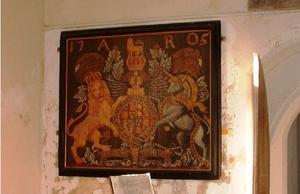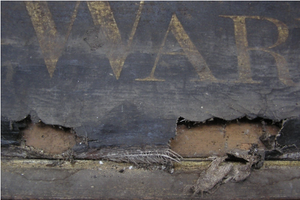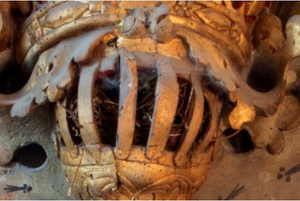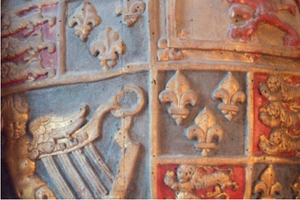The Impact of the Environment
The Uncomfortable Life of Paintings in Churches

The Uncomfortable Life of Paintings in Churches
Church interiors often provide harsh environments for paintings, typically high humidity, low temperature, lack of ventilation and uncontrolled light. The impact of the environment can therefore be severe.
Large-scale deterioration is possible as is rot, woodworm infestation and corrosion, which can be responsible for the loss of large areas. Many Royal Arms are hung at height, so deterioration may not be noticed until it has reached a fairly advanced stage.
However, not all environmental problems are inevitable: care must be taken when installing heaters or lights, for example as these set close to Royal Arms coupled with intense heating during services can initiate or accelerate deterioration at an alarming rate.

Paintings and People
Paintings and people do not happily share the same environment. Humans are sensitive to relatively small changes in temperature and largely unaware of changes in humidity. Paintings, however, are far less sensitive to temperature, but even small fluctuations in humidity can initiate or exacerbate reactions in their materials.
These reactions may include joints and seams opening, wood warping and splitting, canvas tearing and distorting, paint cracking, lifting and flaking, wet and dry rot, rust, corrosion and the growth of algae and mould.
Light may trigger further, albeit less severe, reactions. The effects of light and in particular ultraviolet radiation can be observed in the fading or alteration of pigments, darkening of varnishes, cracking of paint and frame mouldings and the loss of strength of textiles.

Bats, Beetles, Mould and Dirt
The church environment may enable organisms such as birds, bats, textile moths, woodworm and deathwatch beetle to thrive largely undisturbed. Their presence may result in extensive damage to paintings. Further detrimental effects may be seen when mould growth occurs, often causing staining and damage to surfaces.
Paintings provide both food and lodging for many of these organisms:
- Animal glue used in the preparation of canvases feeds mould growth
- Wooden panels, frames and stretchers, often in contact with damp walls, can harbour beetle infestation and bats may roost behind paintings

The inevitable build-up of dirt that occurs when a painting remains undisturbed for sometimes several centuries, can also lead to damage: dirt and debris filling up the reverse of a canvas until it rots or tears.
While treatment and good housekeeping may control some of these problems, it is very difficult to eradicate them completely. In most cases Royal Arms and their unwelcome guests have had to learn to live together, with damage kept to a minimum.

